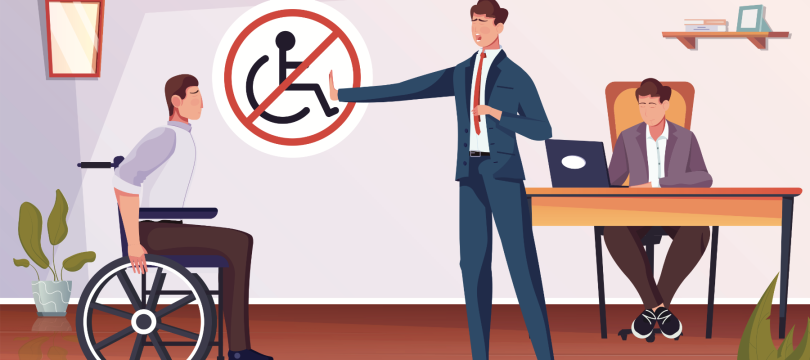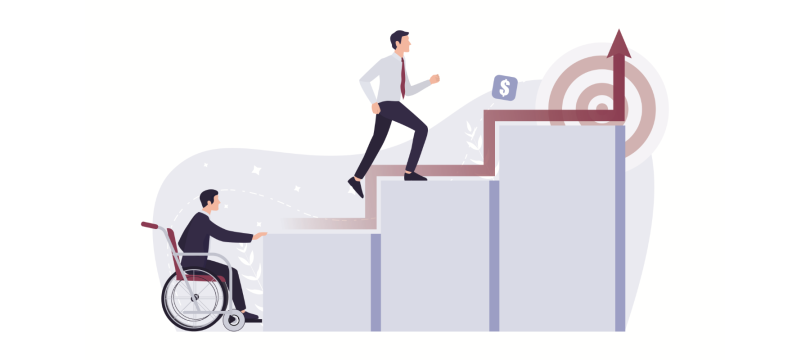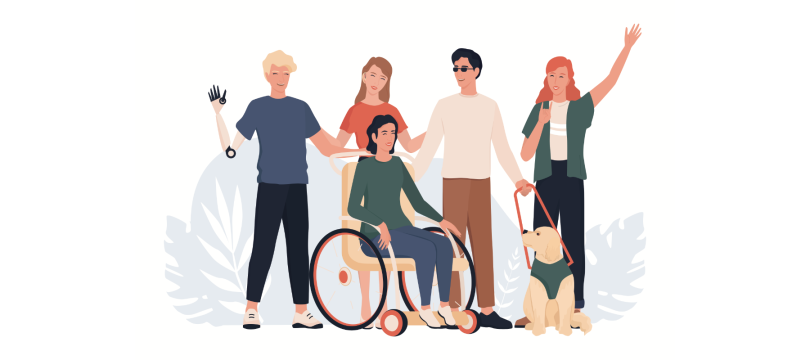When Josh Basile was 18, he and his family took a beach vacation. Basile grabbed his boogie board and headed into the pounding surf. A giant wave caught him by surprise, smashing him headfirst into the ocean floor. The incident crushed the fifth vertebrae below his skull, and Basile emerged from the ocean a quadriplegic, paralyzed from the shoulders down.
What are Ableist Attitudes and Ableism?
Basile, now 35 and an attorney, disability activist and community relations manager for accessiBe, an AI-powered web accessibility hub, realized that he’d have to reimagine the life he had planned. He might not quite have grasped, though, that in becoming one of 61 million Americans who have a visible or invisible disability, he would face a lifetime of judgments.

What Are Ableist Attitudes?
Ableists judge people based on assumptions and presume disabled people are inferior. They can act out of intentional cruelty or out of true ignorance about disabilities — including the fact that due to the unpredictability of life, anyone can become disabled at any time.
Before his accident, Basile had not known a single person with a disability. “I did not ‘get’ disability,” he said. If he did see someone on the street in a wheelchair, “I had a perspective of ‘I’m so sorry for that person,’” he said. Sympathy, a natural human emotion, can quickly feel patronizing to people with disabilities.
“Even something seemingly innocuous as speaking loudly to someone who is blind, or talking down to someone in a wheelchair, is ableist.”
Ableist attitudes extend to people with visible disabilities as well as invisible disabilities, for instance vision or hearing impairment. These disabilities become even more invisible in the age of digital workplaces. “You may be working every day with people who have disabilities,” said Ashley Eisenmenger, public relations coordinator at Chicago-based Access Living, a nonprofit that helps people with disabilities with housing challenges. “They use assistive technology, they use accommodations, and you don’t necessarily know” that they have a disability, said Eisenmenger, who is blind.
DEI experts offer solutions to create a radically inclusive workplace.
Ableist attitudes are also baked into federal and state legal and building codes as well as business policies and procedures, said Jarah Moesch, a lecturer in the department of science and technology studies at Rensselaer Polytechnic Institute in Troy, New York. “Ableism is ingrained in U.S. society, laws, customs, social practices, language,” Moesch said. “It takes a conscious effort (by the non-disabled) to continuously recognize and attempt to change and rectify.”

From Ableist to Ableism
Ableism like racism, sexism, ageism and other -isms, excludes and diminishes an entire demographic. Ableism can be as blatant as having an office space that isn’t designed for people who are blind or use a wheelchair or planning an office outing that excludes everyone but athletic able-bodied employees, or developing a website that ignores accessibility standards.
Discrimination, Direct Bias and Implicit Bias Against People with Disabilities
- Discrimination is the act of applying a bias to an action that violates a law, for instance the 1990 federal Americans with Disabilities Act, said Dr. Tracy Pearson, an expert in law, accountability, culture and implicit bias who serves as a legal analyst, researcher and consultant.
- Direct bias is a known belief that guides decisions and leads to discrimination, for instance not hiring a disabled person because of the belief that the person will underperform or prove costly to the organization.
- Implicit bias is an unknown belief that influences a person’s thinking without their awareness. One example is planning a group event that ignores the needs of people with mental or physical disabilities and makes participation impossible or uncomfortable for them.
- Another example: Criticizing an employee with PTSD or depression, both types of non-invisible disabilities, as “overly sensitive” for crying, while the tears might well be an anxiety response. Ruling out people with disabilities for promotions and being dismissive of people who ask for help can also be manifestations of implicit bias.
Ableism can seep into our everyday language. These microaggressions include referring to something as “lame” or describing an oversight as “a blind spot” or an idea as “falling on deaf ears,” according to Access Living’s guide on ableism. Extreme examples of ableism include using the words “crippled” and “retarded” and “psycho,” asking upset people if they are “off their meds” and even telling people “I don’t even think of you as disabled.”
Ableism affects how others refer to people with disabilities, said Moesch. “Disabled people” is identity-first, while “people with disabilities” is person-first; one’s preference depends on the role disability has played in their lives, Moesch said. Some people, for instance many deaf and blind people, “don’t consider those to be impairments,” Moesch said. “For many folks, disability itself is located in society, not the individual.”
Sometimes, “‘disabled people’ is used by those whose world view, perspective and/or way of life is the way it is because of their disability — they wouldn’t be who they are otherwise,” Moesch said. As for “differently abled,” that’s a way to avoid using the word disabled. “That translates to disability being considered bad, which it isn’t. People who use this phrase either don’t know any better or they aren’t listening to people with disabilities/disabled people.”

The Effects of Ableist Attitudes
Eighty-two percent of people with disabilities are unemployed, even during labor shortages. Only 2 percent of the internet is fully accessible to people with disabilities. They are not taken seriously as consumers despite the fact that as a group, they possess $21 billion in discretionary income, according to data from the American Institutes for Research.
In 2020, disability discrimination formed the basis for more than one-third of charges filed with the Equal Employment Opportunity Commission. “We also know from empirical research that people with disabilities face lower performance expectations and bias in hiring decisions, but receive more positive performance evaluations,” said Dr. David Dwertmann, associate professor of management at Rutgers University. The effects differ somewhat by type of disability. For instance, people with mental disabilities face the lowest performance expectations and the biggest bias in hiring decisions, Dwertmann said.
Employers can and do harbor concerns about hiring people with disabilities. One fear is that customers will react negatively to people with disabilities in public-facing roles. Others: People with disabilities can’t fulfill certain tasks; that they will run up costs due to accommodations and healthcare costs; and that there aren’t high-quality candidates who are disabled. Fear of litigation, discomfort or unfamiliarity with disabilities, and attitudes from coworkers and supervisors also are among employer concerns, Dwertmann said, citing his own and colleagues’ research.

Workplace Ableism
In the workplace, ableism ranges from organizing activities that not everyone can participate in to being passed over for promotions to being overlooked when it comes to office moves.
“There’s definitely work to be done,” said Jack Chen, a Harvard graduate and assistant general counsel at Meta, who became blind at age 16 following complications from an injury. “We don’t see open people with disabilities in leadership positions at our biggest corporations.” Chen said that he has, in many cases, not been advanced as quickly as his similarly situated counterparts. “Essentially, I was always kept busy, but I never found myself given the kinds of impactful and challenging projects that would set me up for advancement,” he said.
“Managers have rarely taken the time to truly understand my challenges and help advocate for challenges that would help me to be successful.”
Accessing online systems has been a challenge throughout his career, so he’s spent “an inordinate amount of time” working with engineers to make sure that systems work for people with disabilities. “This is work I must do in order to complete my work and to enable me to be productive on par with my sighted counterparts,” Chen said.
Finding ways to make systems accessible, however, takes away from his assigned work and is never part of his job description, Chen said. “It either takes away from other impactful work I could do or I spend time on my own, after hours, working on these initiatives,” he said. When Chen told one manager about the extra things he needed to do just to perform his job, the manager told him it would hurt him in performance evaluations. “Managers have rarely taken the time to truly understand my challenges and help advocate for challenges that would help me to be successful,” Chen said.
Chen taught himself Braille days before taking the SAT. He gained admission to Harvard, and has worked at top-tier tech firms, including Google and now Meta. He launched Meta’s first disability-focused employee resource group in the legal department, the goal of which is to make Meta the premier workplace for people with disabilities.
Chen has encountered several common workplace misconceptions regarding people with disabilities. One: “We’re happy just to have a job at all,” he said. “The reality is that we want to advance, grow and achieve the highest level or leadership role in our organization.” Another is that disability gets in the way of accomplishing goals. “On the contrary, disability can help to drive greater results,” Chen said.
In a prior job, Tabitha Haly found her needs disregarded when her team was relocated to a basement from the first floor of a building. Haly, who has muscular dystrophy and uses a power wheelchair, asked her manager if they could walk through an emergency exit plan.
“Asking and then going through the tour brought forth so many moments of incredulous questions from the building manager, almost as if they were trying to make me feel bad,” said Haly, now vice president and a software engineer at JPMorgan Chase. The exit issues were resolved and Haly felt that she could be safe in a lower-level workspace.
Haly, who said she has felt discriminated against many times during her career before joining JPMorgan Chase, adds more workplace misconceptions: “That we are all the same,” she said, when in fact people with disabilities are like all people, each with unique qualities, and that disabled people enjoy or indulge in asking for accommodations. “It’s actually the opposite — people with a disability look forward to a time when barriers are not prominent,” she said.
Being perceived as contributing less in the workplace and the idea that “we give up or give in after encountering discrimination” is another common misconception, Haly added. “Personally, I get even more driven to help promote positive change after being treated as if I am inferior,” she said.
“People with disabilities have to prove themselves every day because they’re already at a disadvantage,” said Jim Sinocchi, head of disability inclusion at JPMorgan Chase. “Stigmas are dissolving, but they’re not going away as quickly as we’d all like,” he said. “As a quadriplegic, I speak from experience.”

Ableist Policies and Practices
The landmark Americans With Disabilities Act of 1990 prohibits discrimination based on disability. It also requires employers to provide reasonable accommodations for people with disabilities, and buildings and workspaces are supposed to be accessible.
Three decades later, however, only one-third of managers claim to know the details of the ADA’s legal requirements for accommodating people with disabilities, with an additional 36 percent saying they know “a good amount,” according to a 2020 report from tech HR company UKG. The report surveyed 1,000 managers at U.S. companies with 150-plus employees.
“Organizations as a whole still have a long way to go in creating more inclusive cultures in general, so there is much more work to do even for making our workplaces more accessible and welcoming to people with disabilities,” said Dr. Shirley Davis, president and CEO of SDS Global Enterprises, which specializes in HR strategy, talent management, culture transformation and DEI.
“Historically, we have been taught to not talk about people’s disabilities, and HR implicitly (and sometimes explicitly) made it company policy not to talk about it,” she said. “I am seeing that change. More companies are leaning into those ‘taboo’ topics, especially given the conversations about racial inequity, and the need for greater inclusion and belonging.”
Among the policies and practices that are ableist: Citing the ability to lift a certain weight in a job description when it’s not an essential function of the job; not labeling a restroom stall as “accessible” and allowing everyone to use it, rather than the people who need it; not giving a disabled person extra time to complete a task; or having an EEOC statement that doesn’t include a company’s commitment to hiring people with disabilities, Davis said.
Create an Equitable Workplace for People with Disabilities
- Rethink your company’s values and practices around productivity. What are the needs of your employees?
- Instead of having fixed start and end times for work, institute core hours that everyone is generally available for meetings to be scheduled.
- Start and end meetings on time, and provide breaks in longer meetings.
- Enable people to work as remotely/asynchronously as possible.
- In job descriptions: List its capacity for remote or asynchronous work; do not list requirements that aren’t absolutely necessary; provide alternate ways to apply, including a way to request American Sign Language; make forms and career pages accessible; and provide details about access to the workspace in the description.
“HR policies are typically vague or nonexistent for disability accommodation,” said Dr. Tracy Pearson, an expert in law, accountability, culture and implicit bias who serves as a legal analyst, researcher and consultant. “There are hurdles that employees must jump through to obtain accommodations,” she said.
For instance, when employees who needed to work from home because of disabilities asked to do so pre-pandemic, the answer generally was no, Pearson said. “When the abled employees’ health was jeopardized, working from home was a necessity,” she said. “Inclusion of employees with disabilities is just at the beginning,” she added.
Hiring processes that use AI to filter candidates can also be ableist, as “AI technology is only as good as those programming it,” Pearson said. “If the AI system hasn’t been accounted for and mitigated against implicit bias toward disabled employees, then disabled employees will be disparately impacted,” she said.
For instance, AI parameters might be set to flag resumes that show a disruption in employment, which might be the case for candidates with disabilities, especially given the pandemic, Pearson said. Parameters also might be set to reject applicants with the inability to lift 10 pounds, even though a person could perform the job with accommodations.

Dismantling Ableism
Companies can take solid steps to identify and repair ableist attitudes. “The first step is to recognize their own privilege,” Pearson said. “They need to try to experience the world through the eyes of a disabled employee trying to gain equal access to the workplace,” she said. Companies also need to identify their implicit biases and where those biases hide in policies and procedures, a process that requires special training, Pearson added.
Managers can survey employees to discover how a company can be inclusive. “Ask the staff through surveys, focus groups, exit interviews, and in one-on-one interviews how the company is doing in its treatment of people with disabilities or with diversity in general,” Davis said. She suggested reviewing complaint processes to identify trends and issues that might reveal opportunities to improve. “Ask experts who have extensive knowledge about how to best serve people with disabilities,” she said.
What Tech Can Do to Include All
- Track progress. “It is incredibly important to be able to track our progress,” said Jack Chen, assistant general counsel at Meta. Companies run into trouble with legal requirements about what data can be collected about people with disabilities,” he said. Tech needs to find a framework that allows a better understanding of where it needs to progress, and track that progression. “Without data, we cannot do that effectively,“ he said. “This is the only diversity category that experiences blocks with data analytics.”
- Strive for accessibility by design, “not after the fact or done based on someone’s running into inaccessibility challenges.” Chen said. “If we don’t do this, we restrict people from entering into jobs in certain departments based on the online tools.”
- Hold vendors to rigorous standards. “Companies bring in a lot of vendor software,” Chen said. “However, it is difficult to understand the accessibility of that software ahead of time, and once the software has been onboarded, it is difficult to convince these companies to make accessibility changes. We as companies need to demand accessibility from our vendors.”
Policies, too, should be reviewed to ensure that they are inclusive of people with disabilities, that accessibility is considered, and that accommodations are available for those who need them, Davis said. Companies can provide education and skill-building about how to work effectively with people who have disabilities — and make sure that the training and education dispels myths and teaches appropriate terms and language. “What was used years ago has changed,” Davis said, pointing to the word “handicapped” as an archaic term and “neurodiverse” as a newer and acceptable term to refer to people whose brains process information differently. Company DEI vision statements should explicitly include people with disabilities, Davis said.
JP Morgan Chase formed an Office of Disability Inclusion in 2016 to make it an employer of choice, and a bank of choice, for people with disabilities, Sinocchi said. “Disability inclusion isn’t just a catchphrase — it’s a way of life and business imperative,” he said.
The office focuses on four areas: attitude, accessibility, accommodations (including a global tech team that evaluates internal and vendor-provided software applications for accessibility) and assimilation. Assimilation includes company initiatives such as Autism at Work, for neurodivergent people, and its Business Solutions Teams for people with intellectual and developmental disabilities.
The bank’s Access Accessibility Business Resource Group has 18,000 members — including allies and employees who are caregivers — around the globe. The group hosts events such as teaching American Sign Language or hosting panel discussions. Tabitha Haly belongs to the New York/Connecticut/New Jersey chapter. “Their presence at the firm, even externally representing the firm, provides great comfort and community,” Haly said.
“We face barriers every day that don’t even come across the radar of persons without disabilities. To be able to overcome those barriers strengthens our ability to acknowledge a problem and then find a solution. That’s such a powerful thing to bring to the workforce.”
Ten online Disability Inclusion Resource Guides, created in partnership with Cornell University’s Employment and Disability Institute, help JPMorgan Chase employees and managers foster an inclusive environment, for instance offering guidelines on how to effectively discuss assistive technology needs for employees. Sinocchi and his staff also lead live trainings for departments and teams. Sinocchi added that employees like Tabitha Haly lead by example, and regularly share stories about their lives with disabilities. “It’s become part of our culture,” he said.
Assistive Technology in Action
Eighty-five percent of the staff at IT consultancy Accessibility Partners, including the three founders, identify as having a disability. The founders, all disability advocates and tech professionals, launched the company in 2009 to make tech more accessible for people with disabilities. The tech spans all industries and has about 10 employees, said Sharon Rosenblatt, director of communications.
It is not difficult to spot ableist attitudes and take steps to fix them, Rosenblatt said. For instance, take note of how employees talk about and speak to other employees. “Even something seemingly innocuous as speaking loudly to someone who is blind, or talking down to someone in a wheelchair, is ableist,” she said.
So is making assumptions about a person’s ability or productivity (for instance, that a blind person can’t use the internet) based on their disability, worrying that people with disabilities might someday sue the company, or buying a one-size-fits-all tech solution, especially one that is largely visual or auditory.
Employees, all of whom work from home or a co-working space, use assistive equipment such as Siri talkback, refreshable Braille displays, screen readers that provide voice and Braille transcriptions of text on screens, magnifiers and ergonomic devices. “Assistive tech and accommodations are less expensive than you may think,” said Dana Marlowe, founder and principal partner. “They are ultimately productivity boosters, and shouldn’t be seen in any pejorative light,” she said. Assistive tools create an inclusive culture as all employees are performing the same function, regardless of the equipment they use.
And employees with disabilities, for their part, do much to create a vibrant, innovative workforce. “Persons with disabilities are incredible workers, they’re incredible contributors,” said Josh Basile of accessiBe.
“We face barriers every day that don’t even come across the radar of persons without disabilities,” Basile said. “To be able to overcome those barriers strengthens our ability to acknowledge a problem and then find a solution,” he said. “That’s such a powerful thing to bring to the workforce.”
Employer Resources
Here are resources that can help transform an ableist culture into one that welcomes and includes people with disabilities.
- Americans with Disabilties Act (ADA), passed in 1990, guarantees rights for people with visible and invisible disabilities. The site offers tools and information for compliance with this groundbreaking federal legislation.
- The Campaign for Disability Employment champions the hiring of people with disabilities. Its “Who I Am” public service announcement campaign features nine people with disabilities sharing their personal stories, occupations and family relationships.
- Disability:IN, an organization that empowers employers to achieve disability inclusion and equality. Its annual Disability Equality Index, a collaboration with the nonprofit American Association of People with Disabilities, scores companies on their accessibility and provides benchmarks for improving workplace accessibility.
- Flexability is woman-, disability- and LGBTQ+ - led company that helps organizations implement all types of workplace equity.
- Job Accommodation Network (JAN) offers free and thorough information for all kinds of businesses on making the workplace accessible.
- Web Accessibility Initiative (WAI) promotes web accessibility, crucial as less than two percent of the global internet is accessible. The initiative offers Web Accessibility Content Guidelines and other information on how to make websites fully accessible.
DEI experts offer solutions to create a radically inclusive workplace.




